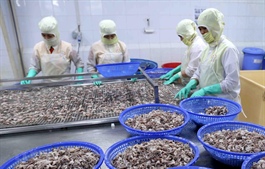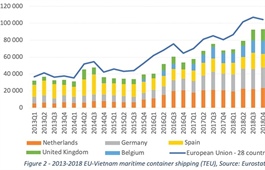Fruit exporters seek new markets to survive pandemic
Fruit exporters seek new markets to survive pandemic
Chanh Thu Fruit Import and Export Company Limited in Ben Tre Province continues to operate normally despite the resurgence of COVID-19 since it has shifted to new export markets instead of overly depending on traditional ones like China.

Ngo Tuong Vy, its deputy director, said exports of frozen durian have increased by more than 30 per cent.
“Frozen durian is popular since the quality is almost fresh after thawing. Frozen durian is also mouth-watering as it is similar to ice cream and the smell is not as strong compared to when it is fresh.”
The company now focuses on exports to the US, she said.
“There is no shortage of durian in the US market, but Vietnamese durian is popular since it is delicious yet reasonably priced.”
This month, despite a significant drop in the prices of dragon fruits, farmers in Long An Province’s Chau Thanh and Tan Tru districts were still able to sign a contract with Lavifood, an exporter of processed fruits and vegetables, to sell the fruit at VND13,000 and VND23,000 ($1) per kilogramme, depending on quality, relatively higher than the market price.
Lavifood buys 80 per cent of the fruits grown in Long An.
Dang Ngoc Can, general director of the company, said it has focused on the processing of dragon fruit into juice, dried and frozen products.
The company has a factory in Long An Province with an annual capacity of 10,000 tonnes of processed products, and another in Tay Ninh with a capacity of 60,000 tonnes, and could process more than 500 tonnes of dragon fruit per day, he said.
The company plans to increase exports to markets with high demand such as South Korea, Japan, the US, and Europe, he said.
Nguyen Quoc Trinh, chairman of the Long An Dragon Fruit Association, said his company bought 500 tonnes of the fruits at high prices within 10 days of harvest, making farmers very happy.
“Farmers can export ‘beautiful looking’ dragon fruits and keep the rest for freezing, drying and making juices for domestic consumption.
“The price is based on how the fruits look.”
To sell well, farmers must follow “clean” processes based on VietGAP standards, he said.
Nguyen Dinh Tung, chairman and general director of Vina T&T Group, said the company’s plant could preserve fresh coconuts for 80 days, 20 more than before, and targets new markets like Australia, Japan and Korea in addition to its traditional market, the US.
“The company exports eight to nine containers of coconuts a week now, compared to only three or four in past years. Each container contains 20,000 coconuts. To get 20,000 good coconuts, the company has to buy 30,000-40,000 from farmers.”
Phung Van Hien, director of Global Fresh Fruit Company Limited (Ben Tre), said the company decided to suspend rambutan exports to the EU a few months ago because of lack of supply due to the saltwater intrusion and drought in the Mekong Delta, and the Covid-19 outbreak, and surge in air freight.
It quickly found new export markets like Japan, Australia and the US for fresh coconuts instead, he said.
It also exports copra to the Netherlands, he said.
“Businesses must now focus on quality and branding their products to ensure sustainability.”
According to the Viet Nam Fruit and Vegetable Association (Vinafruit), exports to China, the country’s largest market, were only worth VND1.044 trillion ($45 million) in the first half, down 29.35 per cent year-on-year.
It attributed the slump to the fact that cross-border trade has been tightened due to the pandemic, causing shipments of many agricultural products, including dragon fruit, to be stuck at the borders for days.
To survive, businesses have to expand to new export markets and learn to adapt to each market’s tastes and improve quality, packaging and traceability, according to the association.
Recommendations
The agricultural sector is expected to continue facing challenges this year due to the pandemic and unfavourable weather conditions.
Experts said it should continue to adapt to climate change, use technology and improve human resources.
Enterprises need to continue to seek new markets, they added.
The sector has a growth target for the agriculture, forestry and fisheries sector for this year of 2.6 – 3 per cent, the same as last year, with exports rising to $41 billion.
To achieve the target, it should also take advantage of tropical agriculture and develop high-quality specialised areas that meet food safety requirements, the experts said.
It should speed up key projects in agricultural and forestry processing and increase the capacity of existing processing plants to reduce costs and serve domestic and export needs, they said.
Agriculture should be closely linked with the processing industry and preservation, market, export, and global value chains.
Minister of Agriculture and Rural Development Nguyen Xuan Cuong said his ministry expects to quickly establish linkages between cropping areas, processing plants and logistics systems to expand export markets and join the global value chain.

























